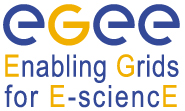Speaker
Describe the added value of the grid for your activity, or the value your tool or service adds for other grid users. This should include the scale of the activity and of the potential user community, and the relevance for other scientific or business applications.
Quattor has proved to be an excellent toolkit for managing distributed sites. It is a complete fabric management system that provides full life-cycle management of grid nodes from initial installation to ongoing maintenance. It has a flexible architecture that allows services to be located at different points in a distributed infrastructure, facilitating the use of shared servers. Quattor uses a high-level language, Pan, that provides good support for structuring and sharing configuration information, and for validating parameters. In fact, collaborating sites including GRIF, Grid-Ireland, and BEgrid have developed a comprehensive set of Pan templates allowing configuration of OS and grid services. This model allows sites to easily share common configuration information while maintaining the ability to apply local customisations. We present an overview of Quattor for grid site management, with a particular focus on successful distributed deployments.
Report on the impact of the activity, tool or service. This should include a description of how grid technology enabled or enhanced the result, or how you have enabled or enhanced the infrastructure for other users.
The Quattor Working Group (QWG) configuration templates developed as a collaborative effort between LAL, Begrid, Grid-Ireland, and others, now provide a comprehensive distribution allowing installation, configuration, and maintenance of grid and non-grid machines. They provide a mature distribution with standard methods for importing updates such as OS descriptions, grid middleware updates, and VO configurations. They have proved an effective mechanism for sharing expertise: any QWG user may check modifications developed locally into the central repository. Modifications are tested and integrated into regular releases. A comprehensive set of grid node types are supported, along with basic non-grid nodes. Distributed grid infrastructures such as Grid-Ireland (18 sites), Begrid (6 sites), and GRIF (6 sites) have been successfully using the QWG templates to manage their grid installations for around three years.
Describe the activity, tool or service using or enhancing the EGEE infrastructure or results. A high-level description is needed here (Neither a detailed specialist report nor a list of references is required).
It is increasingly common for multiple physical locations to pool their resources as a single distributed grid site. For example, the GRIF site in the Paris region presents the resources of six institutions as a single Tier-2 site. This can reduce administrative overhead by concentrating shared configurations, and can improve reliability by making it easy to deploy updated configuration and software. The Quattor toolkit has proved to be ideal for implementing such an infrastructure.




